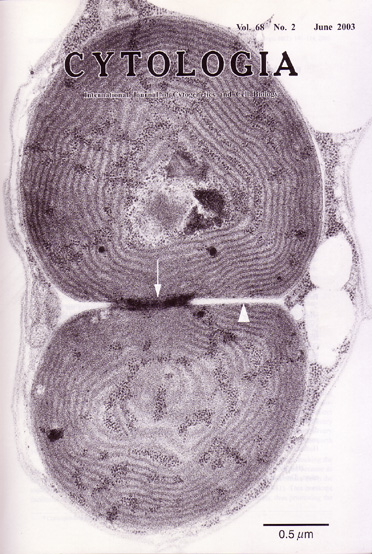| ON THE COVER |  |
|---|---|
| Vol. 68 No.2 June 2003 | |
| Technical note | |
|
|
|
| Chloroplasts of Glaucocystophyta, like Cyanophora paradoxa, possess the most primitive features among the known plastids, resembling
cyanobacteria in the presence of' a surrounding peptidoglycan layer, pigment
composition and morphology, and hence they are called 'cyanelles'. Recently
electron microscopic observations have revealed that the cyanelle division
of C. paradoxa represents an intermediate stage between cyanobacterial and plastid division.
The cyanelle division involves ingrowth of the peptidoglycan-containing
septum at the cleavage site (arrowhead). On one hand, only a single plastid dividing-ring (cyanelle ring) (arrow) is formed on the stromal face of the inner envelope membrane at the isthmus,
but cytosolic plastid dividing-rings, which are common in the ordinary
plastids, are not detectable on the outer envelope membrane. The absence
of the cytosolic plastid dividing-ring may be accounted for by the septum-based
division mechanism that does not require external mechanical force. According
to the prevailing hypothesis that primary endosymbiosis occurred only once,
the mechanism of the plastid division may have evolved via that of the
cyanelle division of Glaucocystophyta, like C. paradoxa (see Hashimoto, H. 2003: Int. Rev. Cytol., 222: 63-98., Iino, M. and H. Hashimoto 2003: J. Phycol., 39: 561 -569. ). (Haruki Hashimoto, Department of Life Sciences, Graduate School of' Arts and Sciences, The University of Tokyo, Komaba, Meguro-ku, Tokyo, 153-8902, Japan) |
|